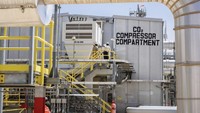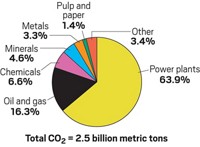Advertisement
Grab your lab coat. Let's get started
Welcome!
Welcome!
Create an account below to get 6 C&EN articles per month, receive newsletters and more - all free.
It seems this is your first time logging in online. Please enter the following information to continue.
As an ACS member you automatically get access to this site. All we need is few more details to create your reading experience.
Not you? Sign in with a different account.
Not you? Sign in with a different account.
ERROR 1
ERROR 1
ERROR 2
ERROR 2
ERROR 2
ERROR 2
ERROR 2
Password and Confirm password must match.
If you have an ACS member number, please enter it here so we can link this account to your membership. (optional)
ERROR 2
ACS values your privacy. By submitting your information, you are gaining access to C&EN and subscribing to our weekly newsletter. We use the information you provide to make your reading experience better, and we will never sell your data to third party members.
Greenhouse Gases
DOE details how it will dole out DAC dollars
Energy Department sets a brisk pace for deploying federal dollars on carbon management
by Craig Bettenhausen
December 19, 2022

The Biden administration is moving quickly to implement carbon dioxide management provisions in the 2021 federal infrastructure bill and the Inflation Reduction Act that became law this summer. The US Department of Energy opened more than $1.4 billion in funding on Dec. 13 to applications, proposals, and bids for direct air capture (DAC), carbon utilization, and CO2 infrastructure projects.
The agency will put most of the funding, $1.2 billion, toward four DAC hubs to be built across the US. The DOE wants the hubs to demonstrate commercial-scale DAC technologies with the capacity to pull 1 million metric tons (t) of CO2 per year out of the atmosphere and either inject it into stable geological formations or convert it into products.
The funding timeline is aggressive, says Jessie Stolark, public policy manager for the nonprofit Carbon Capture Coalition (CCC). Letters of intent are due near the end of January, the deadline for full applications is in mid-March, and awardees should be notified by the end of June.
This $1.2 billion will be followed by another $2.3 billion funding opportunity a couple of years down the line. Stolark says releasing the money this way will allow breakthrough technology that isn’t ready today to also benefit from federal support, a strategy that CCC and other groups championed in conversations with the DOE earlier this year.
The DOE also launched a $115 million prize program for DAC technology and facilities; $15 million of the cash is set aside for pre-commercial R&D prizes for new DAC methods, and the rest will be awarded to operating DAC plants as they successfully remove CO2 from the air.
Another $100 million will be spent in the form of grants to state and local governments as well as public utilities looking to implement carbon reduction and DAC or to purchase goods made from captured CO2.
Finally, DOE will provide its national laboratories with $15 million to develop methods for measuring, reporting, and verifying CO2 removal. That effort will examine DAC alongside other forms of carbon dioxide removal (CDR) such as biochar burying, ocean pH adjustment, and enhanced geological weathering.
The announcements are a starting pistol for the nascent carbon removal community, according to Frederic Clerc, director of the Carbon to Value Initiative at the Urban Future Lab, a climate tech accelerator. Though the funds from the government were expected, “What has changed is that it’s putting this money to work. It’s now into requests for proposals that people can bid on, they can get selected, and that can get the money out of the door.”
Most of the action in the funding announcement is implementation of the infrastructure bill, which provides direct investment to get DAC plants built, Clerc says. The DAC and point-source carbon capture provisions in the Inflation Reduction Act, in contrast, use the tax code to provide price support for facilities once they’re up and running. A related DOE effort called the Carbon Negative Shot aims to bring the cost of CDR to below $100 per metric ton.
Even proponents acknowledge that DAC and other carbon removal methods are less efficient climate solutions than electrification and point-source capture. Clerc says the majority of green electrons should go to transportation and to displacing fossil fuels used to generate electricity. But carbon removal is important to claw down the atmospheric CO2 concentration and offset persistent emissions.
“People have to understand that CDR is needed by 2050, and at the gigaton scale,” Clerc says, citing recent modeling and projections from the United Nations. “There’s no way we’re going to get to gigaton scale if we don’t start yesterday.”





Join the conversation
Contact the reporter
Submit a Letter to the Editor for publication
Engage with us on Twitter